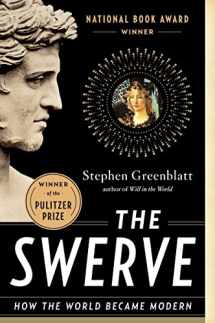
The Swerve: How the World Became Modern
ISBN-13:
9780393343403
ISBN-10:
0393343405
Author:
Stephen Greenblatt
Publication date:
2012
Publisher:
W. W. Norton & Company
Format:
Paperback
356 pages
Category:
History
,
Arts History & Criticism
,
European History
,
History & Surveys
,
Philosophy
FREE US shipping
on ALL non-marketplace orders
Marketplace
from $3.51
USD
Marketplace offers
Seller
Condition
Note
Seller
Condition
Used - Good
Some highlighting and underlining \r\n
Seller
Condition
New
Brand New! Not overstocks! Brand New direct from the publisher! Ships in sturdy cardboard packaging.
Book details
ISBN-13:
9780393343403
ISBN-10:
0393343405
Author:
Stephen Greenblatt
Publication date:
2012
Publisher:
W. W. Norton & Company
Format:
Paperback
356 pages
Category:
History
,
Arts History & Criticism
,
European History
,
History & Surveys
,
Philosophy
Summary
The Swerve: How the World Became Modern (ISBN-13: 9780393343403 and ISBN-10: 0393343405), written by authors
Stephen Greenblatt, was published by W. W. Norton & Company in 2012.
With an overall rating of 3.8 stars, it's a notable title among other
History
(Arts History & Criticism, European History, History & Surveys, Philosophy) books. You can easily purchase or rent The Swerve: How the World Became Modern (Paperback, Used) from BooksRun,
along with many other new and used
History
books
and textbooks.
And, if you're looking to sell your copy, our current buyback offer is $0.45.
Description
Winner of the 2012 Pulitzer Prize for Non-Fiction
Winner of the 2011 National Book Award for Non-Fiction
Nearly six hundred years ago, a short, genial, cannily alert man in his late thirties took a very old manuscript off a library shelf, saw with excitement what he had discovered, and ordered that it be copied. That book was the last surviving manuscript of an ancient Roman philosophical epic, On the Nature of Things, by Lucretius―a beautiful poem of the most dangerous ideas: that the universe functioned without the aid of gods, that religious fear was damaging to human life, and that matter was made up of very small particles in eternal motion, colliding and swerving in new directions.
The copying and translation of this ancient book-the greatest discovery of the greatest book-hunter of his age-fueled the Renaissance, inspiring artists such as Botticelli and thinkers such as Giordano Bruno; shaped the thought of Galileo and Freud, Darwin and Einstein; and had a revolutionary influence on writers such as Montaigne and Shakespeare and even Thomas Jefferson. 16 pages of color illustrations


We would LOVE it if you could help us and other readers by reviewing the book
Book review

Congratulations! We have received your book review.
{user}
{createdAt}
by {truncated_author}



